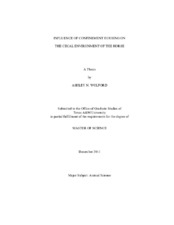| dc.description.abstract | Eight cecally cannulated Quarter Horse geldings were utilized in a crossover design with two 28 d periods with a 21 d washout period between. Horses were adapted to dietary treatments from d 1 to 19, dry matter intake was determined from d 20 to 24, and cecal fluid was collected on d 28. Horses were paired by age and body weight (BW) and randomly assigned to treatment. Treatments consisted of housing horses individually in stalls or group housed in a dry lot pen. Regardless of treatment, all horses were individually fed a pelleted concentrate at 1% BW (as fed) offered twice daily 12 h apart. All horses had ad libitum access to coastal bermudagrass hay. Hay was offered to stalled horses initially at 2% BW (as fed) then adjusted based on 120% of a previous 3 d average of voluntary intake.
A dual marker system was utilized for estimation of voluntary intake in all horses using titanium dioxide (TiO2) as the external marker and acid detergent insoluble ash (ADIA) as the internal marker. Cecal samples were collected 4-h after the morning meal and immediately analyzed for pH. Samples were transported to the USDA/ARS laboratory to enumerate total anaerobic bacteria and lactic acid bacteria, and to determine methane and ammonia activity.
Cecal pH was influenced by housing (P = 0.02) with group housed horses having lower cecal pH values when compared to stalled horses (6.52 +/- 0.04 and 6.69 +/- 0.04, respectively). The cecal pH values of this study are similar to other reported values when feeding similar diets (5). Populations of cecal total anaerobic bacteria and lactobacillus were not influenced by housing (P >= 0.21). Treatments did not affect the production of acetate, propionate, or butyrate (P >= 0.15). Additionally, methane and ammonia production were not affected by treatments (P >= 0.17). Forage intake was greater for group housed horses (P = 0.04) than stalled (8.47 +/- 0.89 kg DM/d and 5.17 +/- 0.89 kg DM/d, respectively). In conclusion, confinement housing did not greatly influence the cecal environment of a horse when similar diets were offered. | en |


